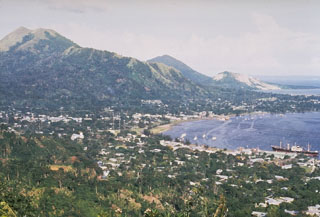Report on Rabaul (Papua New Guinea) — October 1989
Scientific Event Alert Network Bulletin, vol. 14, no. 10 (October 1989)
Managing Editor: Lindsay McClelland.
Rabaul (Papua New Guinea) Seismicity increases slightly; no new deformation
Please cite this report as:
Global Volcanism Program, 1989. Report on Rabaul (Papua New Guinea) (McClelland, L., ed.). Scientific Event Alert Network Bulletin, 14:10. Smithsonian Institution. https://doi.org/10.5479/si.GVP.SEAN198910-252140
Rabaul
Papua New Guinea
4.2459°S, 152.1937°E; summit elev. 688 m
All times are local (unless otherwise noted)
"Seismicity increased slightly in October. A total of 346 events was recorded, compared to monthly totals of 100-200 in the last 10 months. The largest daily event total was 83, recorded on the 24th, when earthquakes occurred in rapid succession for ~2 hours. A similar swarm with a total of 67 events occurred 20-21 October, all with ML <2. No events were felt, and only five were large enough be recorded by the entire network and located. Two events occurred in the NW and one in the S part of the caldera seismic zone. The remaining two events appeared to originate from the E part of the region bounded by the caldera fault. Ground deformation readings in October showed no significant change."
Geological Summary. The low-lying Rabaul caldera on the tip of the Gazelle Peninsula at the NE end of New Britain forms a broad sheltered harbor utilized by what was the island's largest city prior to a major eruption in 1994. The outer flanks of the asymmetrical shield volcano are formed by thick pyroclastic-flow deposits. The 8 x 14 km caldera is widely breached on the east, where its floor is flooded by Blanche Bay and was formed about 1,400 years ago. An earlier caldera-forming eruption about 7,100 years ago is thought to have originated from Tavui caldera, offshore to the north. Three small stratovolcanoes lie outside the N and NE caldera rims. Post-caldera eruptions built basaltic-to-dacitic pyroclastic cones on the caldera floor near the NE and W caldera walls. Several of these, including Vulcan cone, which was formed during a large eruption in 1878, have produced major explosive activity during historical time. A powerful explosive eruption in 1994 occurred simultaneously from Vulcan and Tavurvur volcanoes and forced the temporary abandonment of Rabaul city.
Information Contacts: C. McKee, RVO.

